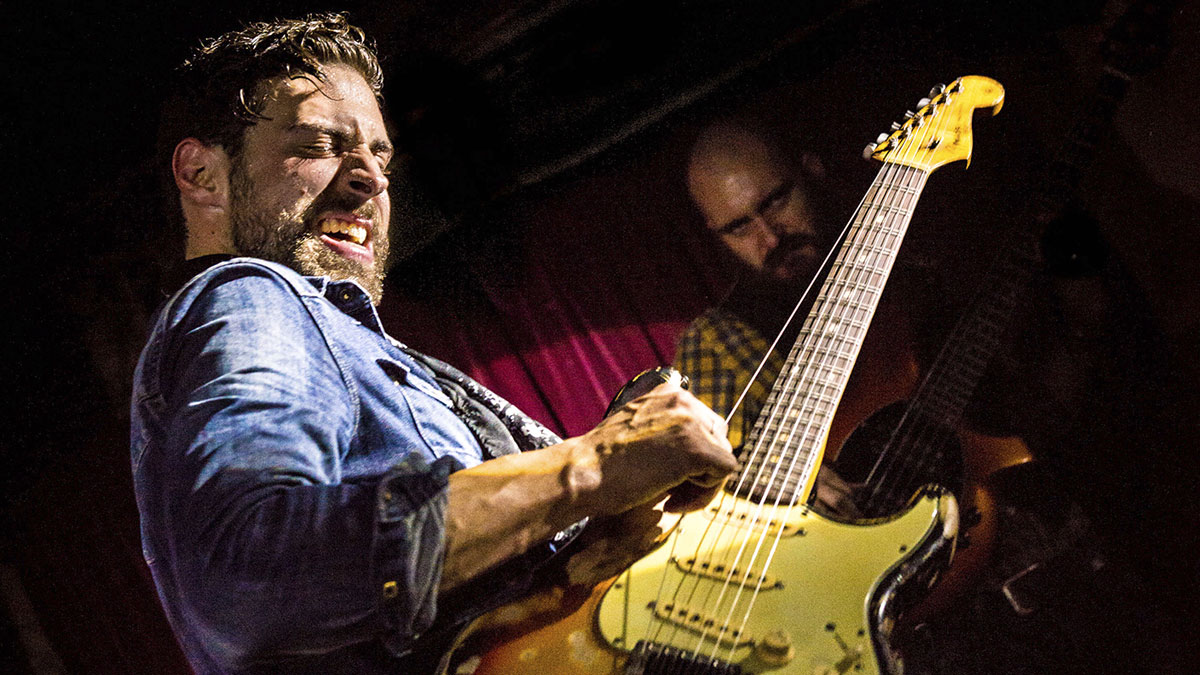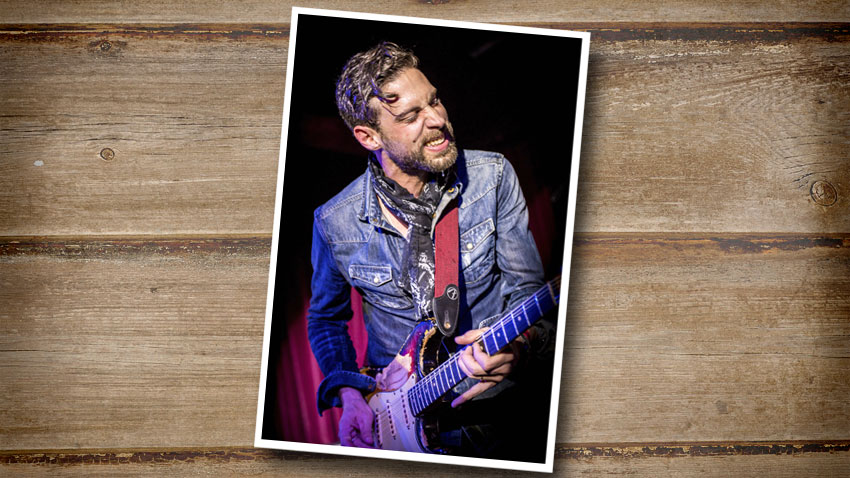Dan Patlansky talks improvisation, phrasing and playing more expressive blues
Sage advice from the South African blues ace

Introduction
Since 2007, South African blues-rock sensation Dan Patlansky has been running an annual series of residential Guitar Weekends in a number of beautiful out-of-town locations in his native country.
Dan's one of the finest bluesmen in the Southern Hemisphere, if not the world
As a result of working with improving classic rock and blues players of all levels, Dan has garnered a reputation as a revelatory guitar tutor and he was more than happy to pass on a slew of pointers, showcasing some of the techniques that make him one of the finest bluesmen in the Southern Hemisphere, if not the world.
And if you haven’t yet sampled Patlansky’s playing - he was most recently seen on these shores shaking up stages as main support for Joe Satriani on his much-lauded Shockwave Tour - then be sure to pick up a copy of his superb 2015 long-player, Dear Silence Thieves. It’s still getting our pulses racing, that’s for sure…
When growing up, which blues-rock and blues guitarists influenced your playing?
“I started off with guys who weren’t really blues guys and who were doing more the classic-rock thing – David Gilmour and Jimmy Page and guys like that. Those are the guys that kind of got me into the guitar-playing thing. I think both those guys came from the blues and my favourite licks they played were from the bluesier side of their playing.
I really got into Clapton, and he does a lot of that kind of looping playing where he’ll take three notes and just loop it and build the tension
“[Hearing] David Gilmour and the Shine On You Crazy Diamond solo really was a massive turning point for me, and that was a blues approach to a solo. It was real sparse, and it was that real ‘phrased’ type of playing. I was like, ‘Wow!’ and all the guys were saying, ‘Well, that’s the blues, man!’
“Then I really got into Clapton, and he does a lot of that kind of looping playing where he’ll take three notes and just loop it and build the tension. Then, I went across the pond to the States, and I discovered Stevie Ray Vaughan and I think, as a blues player, it’s so difficult to ignore a guy like Stevie Ray Vaughan.
“From there, I checked out Stevie Ray Vaughan’s influences and all the Kings – you know, Albert King, the whole Freddie King thing and the BB King thing. Then, I just went back further and got into guys like the slide-guitar players, such as Son House and Robert Johnson and everything in between.”
Dan Patlansky's new album Introvertigo is out in the UK on Friday 6 May 2016.
KING KING: MAY 2016 UK TOUR WITH SPECIAL GUEST DAN PATLANSKY
TICKETS: www.thegigcartel.com
MANCHESTER ACADEMY, THURSDAY 12 MAY
GATESHEAD SAGE, FRIDAY 13 MAY
GLASGOW O2 ABC, SATURDAY 14 MAY
SHEFFIELD CITY HALL, SUNDAY 15 MAY
GLOUCESTER GUILDHALL, WEDNESDAY 18 MAY
CRAWLEY HAWTH, THURSDAY 19 MAY
SALISBURY CITY HALL, FRIDAY 20 MAY
BIRMINGHAM TOWN HALL, SATURDAY 21 MAY
DAN PATLANSKY: MAY-JUNE UK HEADLINE CONCERTS
POOLE, MR KYPS, SUNDAY 22 MAY
SHOREHAM ROPETACKLE, MONDAY 6 JUNE
CARDIFF GLOBE, TUESDAY 7 JUNE
LONDON JAZZ CAFÉ, THURSDAY 9 JUNE
FOXLOW ARTS CENTRE, LEEK, FRIDAY 10 JUNE
CHESTERFIELD REAL TIME LIVE, SATURDAY 11 JUNE
CHESTER LIVE ROOMS, SUNDAY 12 JUNE
Don't Miss

Improvised approach
How would you sum up your approach to soloing and the balance of improvised elements you typically incorporate?
“I’d say that 90 per cent of the time, the solos are improvised, but I always find you can run out of ideas and licks, so I kind of approach it quite differently. I do this technique called ‘milking’. When you think you’re out of ideas, it’s a cool thing just to practise anyway. So, I take four notes and just milk them for every possibility they have in them.
At home, I will just sit with four notes and try and make music... you can bend them, so effectively you get a lot more than four notes out of them
“At home, when I’m feeling like I’m out of tune with the whole playing thing, I will just sit with four notes and try and make music out of them. And you can bend them, so effectively you can actually get a lot more than four notes out of them… but just that little box pattern kind of opens up the rest of the neck to you and you’ve got endless possibilities.
“Also, it means you’re not thinking about note choice, you’re just thinking about feeling the music and trying to make music out of nothing. I find that it’s just such a fantastic tool to open up your playing.”
Do you have any tips in terms of developing an ear for invention in solos?
“I’m telling you [trusting your gut instinct] is the way forward, man. It makes so much sense. If you take all the best improvisers in the world - jazz musicians like Charlie Parker and those kind of guys - I don’t think they were going, ‘I’m playing the Mixolydian scale now’ or ‘I’m going to go to a harmonic minor now!’ They were just playing with their ears and making music, and they were so damn good at it.
“Pentatonics are really easy ones: they’re easy to play and they’re soulful, but you don’t have to think too much about them. If you add all the notes in between and on the outside, you get all the scales anyway and you always know what your safe notes are. So, if you think of your pentatonic notes as safe notes, then that’s home base.
“Any one of those is going to sound pretty good against whatever key you’re playing. Then, use the others as your kind of ‘out-there’ notes, tension notes, and you can kind of cover everything.”

Get rhythm
What advice would you give to guitarists looking to improve their rhythm playing?
“Yeah, I think rhythm playing is something that most guitar players forget about because they just want to get into the soloing and the flashy things. But rhythm guitar playing is possibly even more important than lead-guitar playing.
You’re going to be doing a lot more rhythm when you’re playing in a band than you’re going to be doing soloing
“You’re going to be doing a lot more rhythm when you’re playing in a band than you’re going to be doing soloing, so I think it is such a crucial thing to get under your fingers.
“A cool thing that pushes you in the right direction and makes you want to practise rhythm playing is learning cool chord voicings… when you play a different voicing, they can suggest different rhythms to play. Also, any great guitar player you’ve heard is a fantastic rhythm guitar player.
“I mean, Hendrix was a sublime rhythm guitar player. For the most part, he was playing in a three-piece band where you’ve got to handle the rhythm as much as the soloing. Stevie Ray Vaughan is a great example, too… he was kind of the iconic guy of being able - without even a band - to just play a slow blues, which is a tough thing to play.
“Slow blues is a cool thing to practise, as is taking a song that isn’t a blues and having - I don’t know - three chords like A, C# minor and D and playing off them like Hendrix did, while trying and to keep some sort of rhythm going.”

A resonant truth
We noticed that one of your guitar workshops was labelled ‘Chords And Harmonies.’ Tell us more…
“Yeah, that’s something that no-one’s ever very keen on! Everyone’s like, ‘Oh boring… that sounds like a theory workshop!’ but it’s actually a really important thing. It’s not really about rhythmic patterns, it’s more about opening up your chord playing, changing a familiar shape… the way Hendrix did it, because that opens you up to all sorts of stuff.
We all, as guitar players, are our own worst enemies. There are certain things that you avoid playing and practising, because they’re just a drag
“This workshop is also about getting all these fantastic voicings and adding some tension to your chords. I think the more you explore the chord voicing thing from the rhythmic side, then the more interesting your guitar playing becomes. You can take some boring old songs that you’ve been playing for years and years, and you can really reinvent them - and you do so just by using a different chord voicing. It can become fantastic.”
How far do you notice common elements that particularly hold back players?
“I think we all, as guitar players, are our own worst enemies. There are certain things that you avoid playing and practising, because they’re just a drag to practise. I notice that on [Guitar] Weekends and I always say to the guys about that ‘milking’ technique, taking four notes so you can really sound good.
People saying, ‘That resonates with me because I’m feeling it’ is the most important thing
“A handful of people will do it and you see big results in those guys, because then they go out onto the stage and they do a proper solo and it just sounds more refined and more musical. It’s musical because, all of a sudden, it’s the important things in music that are coming out. It’s the feel and the phrasing and that’s all the listeners are hearing.
“People saying, ‘That resonates with me because I’m feeling it’ is the most important thing. That’s the mindset that you’ve got to change. It’s fantastic to know all the stuff, but it’s got to be a musically listenable thing… and the guys that do that milking exercise do see tremendous results.
“It takes so much willpower to sit for an hour with four notes on a 12-bar blues, busting out every kind of option you can and trying to make music with it. But it pays off, man! I still do it today.”

Hold the line
What techniques can make guitarists more expressive in a blues context?
“It seems obvious, but listen to the right sort of stuff. Constantly listen to blues stuff if you want to be a blues player and metal stuff if you want to be a metal player, you know what I mean? And obviously that milking technique really does bring out a lot of soul in your playing.
As a modern player, you’ve got to be able to play fast and slow. It’s not all about just hanging back
“As a modern player, you’ve got to be able to play fast and slow. It’s not all about just hanging back. It’s great to play fast, because it creates another element to your playing - it makes it more three-dimensional - but it’s [important] to know when to use and not to use that.
“When you’re sitting behind the guitar, you’re thinking, ‘I’m holding back’, but if someone films you playing, you’re never holding back as much as you thought you were. If you’re on stage playing, hold back more than you think you are, and take it one step further back. You’ll be shocked what you hear on the other side - it will be much more musical…”











